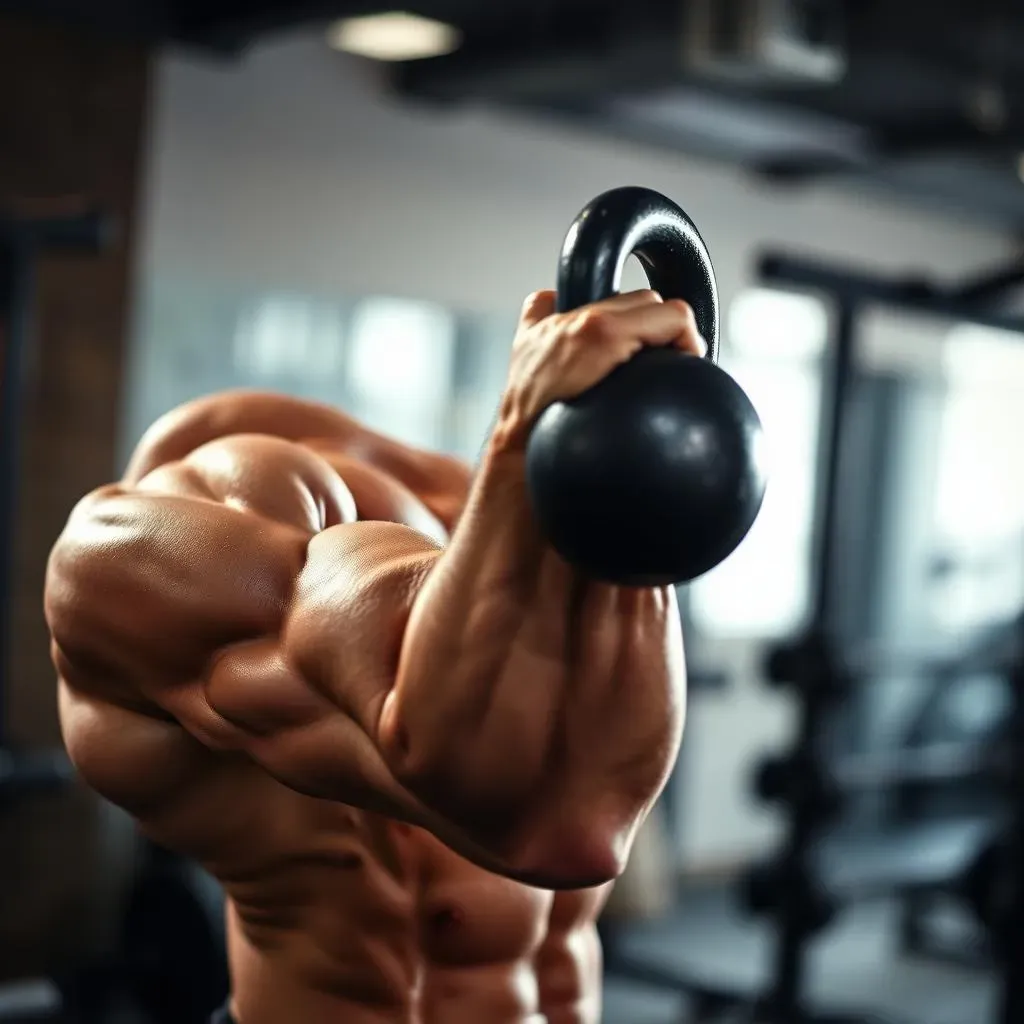Table of Contents
Got shoulder pain? Or maybe you're just looking to bulletproof your shoulders against future aches and pains? Enter the kettlebell. This compact powerhouse isn't just for building a ripped physique; it's a fantastic tool for shoulder rehabilitation, prehabilitation, and overall resilience. And when it comes to bang-for-your-buck shoulder exercises, the shoulder kettlebell swing is a top contender. Forget those bulky gym machines; kettlebells offer a space-efficient, personal solution for building serious shoulder strength.
Why Kettlebells Are Your Shoulder's New Best Friend

Why Kettlebells Are Your Shoulder's New Best Friend
Compact Powerhouse
Let's face it, gym memberships can be a drag. Between the commute, the crowds, and the questionable hygiene, sometimes working out at home just sounds…better. That's where kettlebells shine. They pack a serious punch in a small package. Unlike bulky dumbbells or complicated machines, a kettlebell takes up minimal space, making it perfect for apartment dwellers or anyone who prefers to sweat it out in their living room. Plus, one kettlebell can provide a full-body workout, targeting everything from your legs and core to, you guessed it, your shoulders.
Resistance is Key
Our shoulders are amazing joints, capable of incredible ranges of motion. But that also makes them vulnerable. Think about it: we spend hours hunched over desks, staring at screens, our shoulders rounded forward. This leads to muscle imbalances and weakened stabilizers. Kettlebells provide a unique form of resistance that challenges your shoulders in ways traditional exercises often miss. The offset weight of the kettlebell forces your muscles to work harder to control the movement, building strength and stability in all the right places.
Rehab, Prehab, and Everything In Between
Whether you're recovering from a shoulder injury, trying to prevent one, or simply looking to improve your overall shoulder health, kettlebells can be your secret weapon. The exercises we'll cover aren't just about building bigger muscles; they're about improving joint mobility, strengthening the rotator cuff, and enhancing proprioception (your body's awareness of its position in space). This means you'll not only be stronger but also more resistant to injury and better able to perform everyday activities with ease. Imagine reaching for that top shelf without wincing or playing your favorite sport without fear of tweaking your shoulder. That's the power of kettlebell training.
Benefit | Description |
|---|---|
Space-efficient | Minimal equipment needed, perfect for home workouts. |
Functional Strength | Improves real-world movement patterns and stability. |
Injury Prevention | Strengthens rotator cuff and improves joint mobility. |
Top 5 Kettlebell Exercises for Shoulder Resiliency

Top 5 Kettlebell Exercises for Shoulder Resiliency
Single Arm Kettlebell Swing: The Shoulder Awakener
Alright, let's kick things off with a bang – the Single Arm Kettlebell Swing. This isn't your average swing; it's a dynamic exercise that seriously challenges your shoulder stability. As you swing that kettlebell, the weight wants to pull you off balance, forcing your rotator cuff and scapular muscles to kick into high gear to keep your shoulder joint stable. Think of it as a constant battle against gravity, and your shoulder is the valiant warrior. It's like your shoulder is saying "I got this!".
The beauty of the single-arm swing lies in its unilateral nature. By working one arm at a time, you're not only building strength but also addressing any imbalances between your shoulders. This can be a game-changer if you're dominant on one side or have a history of shoulder issues. Plus, it lights up your core like crazy, forcing you to resist rotation and maintain a stable spine. It's a win-win-win situation!
Pro Tip: Focus on initiating the swing with your hips, not your arms. Your arm is just a rope connecting you to the kettlebell. Let your hips do the work!
Here's a quick breakdown:
- Stand with feet shoulder-width apart, kettlebell in one hand.
- Hinge at your hips, sending the kettlebell back between your legs.
- Explosively drive your hips forward, swinging the kettlebell up to chest height.
- Control the descent and repeat.
Deadlift (and Hip Hinge) Variations: Building a Solid Foundation
Before you can swing like a pro, you need a solid foundation. That's where deadlift and hip hinge variations come in. These exercises might not seem like direct shoulder work, but they're crucial for building scapular stability and correcting strength imbalances. Think of your scapula (shoulder blade) as the foundation for your shoulder joint. If it's unstable, your shoulder is going to suffer.
Even if you have limited overhead mobility due to a shoulder injury, you can still benefit from these exercises. The key is to focus on maintaining proper form and engaging your back muscles to keep your shoulder blades retracted. Variations like the Romanian deadlift (RDL) and the kettlebell swing deadlift are excellent choices for building strength and stability without putting excessive stress on your shoulders. It's like building a fortress for your shoulders, one brick at a time.
Here are a few variations to consider:
Exercise | Focus | Benefits |
|---|---|---|
Romanian Deadlift (RDL) | Hamstrings and Glutes | Strengthens posterior chain, improves hip hinge mechanics |
Kettlebell Swing Deadlift | Full Body | Prepares the body for the kettlebell swing, improves coordination |
Single Leg Deadlift | Balance and Stability | Challenges balance, improves unilateral strength |
Kettlebell Shoulder Swing: Core Engagement and Stability

Kettlebell Shoulder Swing: Core Engagement and Stability
The Anti-Rotation Factor
so we've talked about the shoulder benefits of the kettlebell shoulder swing, but let's get real about the core. This exercise is a sneaky core strengthener. Because you're swinging a weight to one side of your body, your core muscles have to work overtime to prevent you from rotating. This isn't just about getting a six-pack; it's about building a strong, stable spine that can handle whatever life throws at it. It's like your core is the unsung hero of the kettlebell shoulder swing, working tirelessly behind the scenes to keep you upright and balanced.
Think of your core as the foundation of a building. If the foundation is weak, the entire structure is at risk. The kettlebell shoulder swing helps you build a solid core foundation, improving your overall stability and reducing your risk of injury. It's not just about aesthetics; it's about function.
Why is anti-rotation so important?
- Protects your spine from injury.
- Improves athletic performance.
- Enhances everyday movements.
Obliques on Overdrive
While all your core muscles are involved in the kettlebell shoulder swing, your obliques get a particularly intense workout. These muscles, located on the sides of your torso, are responsible for rotation and lateral flexion. During the swing, your obliques fire like crazy to resist the rotational forces, helping you maintain a stable posture. You might not feel them working as much as your shoulders or glutes, but trust me, they're putting in the effort. It's like they're saying, "Don't worry, I got your rotation!".
Strengthening your obliques not only improves your core stability but also helps you develop a more defined waistline. Who doesn't want that? But more importantly, strong obliques are essential for preventing back pain and improving your overall functional fitness. It's a win-win situation!
Real-Life Example: Imagine carrying a heavy bag of groceries in one arm. Your obliques kick in to prevent you from leaning to one side, keeping you balanced and upright. The kettlebell shoulder swing trains this same movement pattern, making everyday tasks easier and safer.
Breathing and Bracing
Proper breathing and bracing are crucial for maximizing the core engagement during the kettlebell shoulder swing. Before each swing, take a deep breath into your belly and brace your core as if you're about to be punched. This creates intra-abdominal pressure, which helps stabilize your spine and protect it from injury. As you swing the kettlebell, maintain this brace and exhale forcefully. It's like you're creating a suit of armor around your spine, protecting it from the forces of the swing.
Many people make the mistake of holding their breath during the kettlebell shoulder swing, which can actually increase intra-abdominal pressure and put more stress on the spine. By focusing on proper breathing and bracing, you can not only improve your core stability but also enhance your overall performance and reduce your risk of injury. It's a simple technique that can make a huge difference.
Integrating Kettlebell Training for LongTerm Shoulder Health

Integrating Kettlebell Training for LongTerm Shoulder Health
Progressive Overload: Your Shoulder's Best Friend
So, you've mastered the single-arm swing and deadlift variations. Now what? The key to long-term shoulder health is progressive overload. This means gradually increasing the demands on your shoulders over time, forcing them to adapt and become stronger. This could involve increasing the weight of the kettlebell, adding more repetitions, or trying more challenging variations of the exercises we've already covered. The goal is to constantly challenge your shoulders without pushing them to the point of injury. It's like you're slowly but surely building a fortress of strength around your shoulder joints.
One way to implement progressive overload is to keep a training log and track your progress. This will help you see how far you've come and identify areas where you need to push yourself harder. Remember, consistency is key. Aim for at least two to three kettlebell workouts per week to see noticeable improvements in your shoulder strength and stability. It's a marathon, not a sprint, so be patient and persistent.
Progressive Overload Strategies:
- Increase the weight of the kettlebell.
- Add more repetitions to each set.
- Increase the number of sets.
- Reduce rest time between sets.
- Try more challenging variations of the exercises.
Listen to Your Body: The Golden Rule
While progressive overload is important, it's equally important to listen to your body. If you're experiencing pain, don't push through it. Pain is your body's way of telling you something is wrong. Instead, back off the intensity, modify the exercise, or take a rest day. There's no shame in taking a break when you need it. In fact, it's often the smartest thing you can do. It's like your body is a wise old sage, offering you valuable guidance. Don't ignore its wisdom.
Remember, the goal is long-term shoulder health, not short-term gains. Pushing yourself too hard can lead to injury, which will set you back even further. Be patient, be smart, and be kind to your body. With consistent effort and a mindful approach, you can build resilient shoulders that will support you for years to come. It's a journey, not a destination, so enjoy the process.
Symptom | Action |
|---|---|
Sharp, localized pain | Stop the exercise immediately and consult a healthcare professional. |
Dull ache that worsens with movement | Reduce the intensity or modify the exercise. |
General muscle soreness | Continue the exercise but be mindful of your form. |
Wrapping Up: Integrated Strength for Shoulder Health
So, there you have it: a roadmap to shoulder resilience using the humble kettlebell. Remember, the real magic happens when you integrate shoulder and core stability. The shoulder kettlebell swing and its companion exercises aren't just about isolating muscles; they're about creating a symphony of movement, where every part of your body works in harmony. Implement these exercises consistently, listen to your body, and watch your shoulder strength and stability soar. Your shoulders (and your entire body) will thank you!